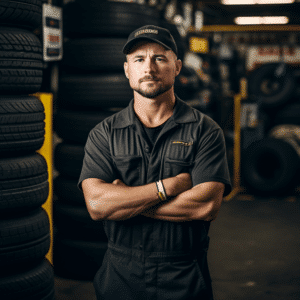
Tire split incidents are more than just an inconvenience—they’re a serious safety hazard. This article explores the primary causes of tire splits, the potential risks to drivers, and preventative measures to take. Stay informed to keep your journey safe.
Key Takeaways
- Tire splits, or tire separations, are caused by manufacturing defects, improper inflation, and excessive wear, each of which can lead to dangerous driving scenarios and severe accidents.
- Preventing tire splits involves regular tire inspections, maintaining proper inflation based on manufacturer’s recommendations, safe driving practices, and effective vehicle load management to ensure even distribution of weight and tire integrity.
- Liability in tire split cases can extend to multiple parties, namely the driver, tire manufacturer, and repair shop, each of whom has specific legal responsibilities for maintaining tire safety and preventing tire splits.
Contact us today and we will help you get the compensation that you deserve.
Tire Split Causes and Dangers
Tire splits, also known as tire separation, are often a result of a combination of various factors, including manufacturing defects, improper inflation, and excessive wear. Each of these factors can compromise the integrity of a tire and lead to disastrous scenarios. A tire split can cause a sudden loss of vehicle control, potentially leading to severe accidents and, in extreme cases, fatal outcomes.
While these causes may appear distinct, they often interplay in the life cycle of a tire. For instance, manufacturing defects may render a tire more susceptible to damage due to improper inflation or excessive wear. Conversely, even a perfectly manufactured tire can split if subjected to improper inflation or extensive wear. Thus, the prevention and management of tire splits require a comprehensive understanding of these root causes and the dangers they pose.
Manufacturing Defects
Manufacturing defects are one of the primary tire tread separation causes. These defects arise from flaws in the tire’s structure or contamination during production, which can compromise the tire’s integrity and increase the likelihood of splits. Specific issues that can result in safety hazards, including blowouts and tread separation, are often related to tire defects such as:
- Belt wedge flaws
- Cap ply defects
- Skim stock flaws
- Inner liner design flaws
- Liner marks
Additionally, contamination during the manufacturing process can lead to the separation, cracking, or opening up of tire liners, contributing to tire failure. Therefore, tire manufacturers must uphold stringent quality control measures to reduce such defects.
Improper Inflation
Improper tire inflation is another major contributor to tire splits. Both underinflation and overinflation can have detrimental effects on tires. Underinflating tires can lead to heightened friction, excessive wear, and overheating, increasing the risk of tire splits. Conversely, overinflation makes tires more prone to punctures and blowouts and reduces traction and handling abilities.
An improperly inflated tire also results in uneven tire wear, subjecting specific areas of the tire treads to heightened stress, thus accelerating wear in those areas. Maintaining the correct tire pressure is thus key to preventing tire splits.
Excessive Wear
Excessive wear, especially when uneven, can weaken the tire structure, particularly in the sidewall, increasing the risk of premature tire failure and tire splits. Indicators of excessive tire wear include:
- Scalloped tires
- Inner edge tread wear
- Worn outer edges
- Worn-out center
These signs often indicate issues such as underinflation leading to wear on both edges, or other conditions causing uneven wear, noise, vibration, and handling issues in vehicles.
Contributing factors to excessive tire wear often include improper inflation pressure, loose lug nuts, and out-of-spec alignment conditions, emphasizing the importance of proper maintenance to prevent premature deterioration and ensure the security of lug nuts and wheel studs.
Preventing Tire Splits

Effective vehicle load management is also a key strategy in preventing tire splits. Some tips for proper load management include:
- Distributing the load evenly across all tires
- Avoiding overloading the vehicle
- Following the manufacturer’s recommended load capacity
- Checking and adjusting tire pressure regularly
Maintaining appropriate air pressure can also prevent uneven wear and contribute to preventing tire splits. These measures collectively contribute to maintaining tire health and ultimately leading to a safer driving experience.
Regular Inspections
Regular inspections play a significant role in preventing tire splits. Inspecting your tires monthly for:
- cuts
- punctures
- bulges
- objects embedded in the tread
- cracks
Proactively addressing potential issues can help ensure you don’t lose control before they escalate into serious problems.
During these inspections, ensure you check the tire pressure and look out for any bulges or blisters on the sidewall. It’s also important to be mindful of common errors during inspections, such as neglecting tire inspection, skipping regular checks, ignoring worn treads, and old tires, misalignment, underinflated tires, and improper storage and installation.
Proper Inflation
Proper inflation is a cornerstone of tire care and plays a vital role in preventing tire splits. Maintaining the correct tire pressure, according to the manufacturer’s recommendations, can extend the life of your tires and improve your vehicle’s fuel efficiency.
Using an accurate tire pressure gauge is necessary when inflating your tires. Here are some tips to keep in mind:
- Check the tire pressure when the tires are cold, as heat can cause the pressure to increase and give a false reading.
- Ensure that you adjust the pressure to match the recommended levels.
- If necessary, release air to prevent overinflation.
Safe Driving Practices
Adopting safe driving habits is vital in prevention tire tread separation. These include:
- Maintaining proper tire inflation
- Inspecting tread for signs of wear
- Regular rotation and maintenance according to correct PSI levels to reduce the risk of tire damage and tread separation, especially when using firestone tires.
Avoiding sudden braking can significantly reduce the risk of tire splits, as it can lead to excessive heat and pressure. Similarly, being attentive to road surface conditions can help identify potential hazards that may cause tire damage. Therefore, practicing safe driving habits should be a part of your routine to prevent tire splits.
Identifying Signs of Tire Split
Recognizing the early signs of tire splits, such as tire tread separation, can help prevent accidents and allow for timely intervention. These signs include uneven wear patterns, sidewall bulges, and unusual vibrations while driving. These signs should trigger a professional inspection to confirm their cause and determine the appropriate course of action.
In addition to visual checks, it’s important to be aware of the feel and sounds of your vehicle. Unusual vibrations or noises could indicate a tire split or other tire issues. If you notice any of these signs, you should immediately seek a professional assessment to avoid potential accidents and ensure your safety on the road.
What to Do If You Experience a Tire Split
A tire split while driving can be a frightening experience. However, it’s important to stay calm and manage the situation appropriately. Safely pulling over, activating your hazard lights, and assessing the damage are the initial steps to take.
After inspecting the flat tire for visible signs of damage, determine whether the tire can be repaired or requires replacement. If in doubt, seek professional advice. A tire specialist or mechanic can provide a thorough evaluation and recommend the best course of action. Ultimately, the safety of you and other road users should be the priority.
Legal Considerations and Liability
Legal considerations and liability in tire split cases can involve multiple parties depending on the cause and circumstances of the incident. These parties can include the driver, tire manufacturer, and repair shop. Each of these parties has certain legal responsibilities, and failure to fulfill these can lead to liability in the event of a tire split.
Understanding these implications is key, especially if you’ve experienced a tire split resulting in property damage or injury. Consulting with a legal professional can help clarify your rights and potential courses of action. Regardless of the circumstances, it’s essential to remember that all parties involved have a shared responsibility to ensure the safety of road users.
Driver Liability
Driver liability in tire split cases usually stems from negligence in maintaining the vehicle, including proper tire care, and adherence to state laws. Drivers have a legal obligation to ensure their vehicle’s safety, and this includes regular tire inspections and maintenance.
In the event of a tire split accident, the driver could be held liable if it’s proven that their negligence led to the incident. This could involve failing to replace worn tires promptly, neglecting tire inspections, or ignoring signs of tire damage. Hence, as a driver, it’s important to meet your legal obligations and make vehicle maintenance a priority.
Tire Manufacturer Liability
Tire manufacturers have a crucial role in ensuring the safety of their products. If a tire split occurs due to a manufacturing defect or design issue, the tire manufacturer could be held liable. In these cases, the victim needs to provide evidence demonstrating negligence or breach of duty by the manufacturer, proof of product defects, and the identification of the responsible parties.
If these elements can be proven, the tire manufacturer could be held legally responsible for the damages caused by the tire split due to a faulty tire casing.
Repair Shop Liability
Just like tire manufacturers, repair shops have a responsibility to ensure the safety of their services. If a tire split is caused by improper repair or installation, the repair shop could be held liable.
Legal cases have set precedents where repair shops have been held liable for tire split accidents. These cases often involve negligence in tire repair practices or failure to adhere to industry standards. Therefore, repair shops must uphold their duty of care to avoid potential liability.
Frequently Asked Questions
Is it safe to drive on a split tire?
No, it is not safe to drive on a split tire as it can lead to separation and make the tire unsafe to use, regardless of the remaining tread.
What is a tire split?
A tire split, also known as tire separation, occurs when the tread of the tire starts to come off of the tire casing, often due to a bonding issue during manufacturing.
How do you know if your tire is splitting?
If your car starts to vibrate when you hit a certain speed, it could be a sign of tire tread separation, though other issues like balance or alignment could also be the cause. Always get it checked to be sure.
Why would a tire come off while driving?
A tire might come off while driving due to common causes such as a broken hub, loose lug nuts, or fastening failure. Always ensure proper maintenance and inspection of your vehicle to prevent such incidents.
How can I prevent tire splits?
To prevent tire splits, you should regularly inspect your tires, maintain proper inflation, and practice safe driving habits, such as effective vehicle load management. These measures are essential for ensuring the longevity and safety of your tires.
Last updated Wednesday, January 24th, 2024






